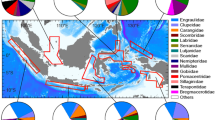Abstract
I tested jetski-based plankton towing as a new method of sampling larval fishes in a shallow marine environment in warm temperate South Africa. Larval fishes were collected by towing a stainless-steel ring net behind a three-man jetski. The sampling technique was designed and tested to overcome problematic sampling of shallow sandy beach surf zones and the adjacent, shallow nearshore immediately seaward of the surf zone (behind the breaker line) with the same type of equipment. The composition, density, stage of development, estuary association, and length frequency of larval fish catches obtained by the new sampling method in the surf zone and in the adjacent shallow nearshore were compared. The success of the technique was evaluated by determining the extent of replication of known trends observed in other surf studies in the same climatic region of South Africa using either a seine or pushnet. Preflexion and postflexion larval fishes were collected. Larvae of the family Sparidae dominated the catches. Trends in catch composition, estuary association, and length frequency of the larvae were similar to those found in other studies of warm temperate South African surf zones. Density of larvae varied depending on the type of equipment used, although these results are tentative given the subjectivity of calculation of the water volume sampled and the extent of nursery use by larvae in the habitats sampled in each study. Increased towing times are recommended. Jetski-based plankton towing is a useful alternative technique for sampling larval fishes in shallow habitats and can easily be applied in surf zones, shallow nearshore areas, and estuaries. The technique greatly increases sampling agility in previously problematic sampling areas.
Similar content being viewed by others
References
Beckley LE (1986) The ichthyoplankton assemblage of the Algoa Bay nearshore region in relation to coastal zone utilization by juvenile fish. South African J Zool 21:244–252
Boehlert GW, Mundy BC (1988) Roles of behaviour and physical factors in larval and juvenile fish recruitment to estuarine nursery areas. Am Fish Soc Symp 3:51–67
Choat JH, Doherty PJ, Kerrigan BA, Leis JM (1993) A comparison of towed nets, purse seine, and light aggregation devices for sampling larvae and pelagic juveniles of coral reef fishes. Fish Bull 91:195–209
Doherty P, McIlwain J (1996) Monitoring larval fluxes through the surf zones of Australian coral reefs. Mar Freshwater Res 47:383–390
Harris SA, Cyrus DP (1996) Larval and juvenile fishes in the surf zone adjacent to the St Lucia Estuary mouth, KwaZulu-Natal, South Africa. Mar Freshwater Res 47:465–482
Harris SA, Cyrus DP, Beckley LE (2001) Horizontal trends in larval fish diversity and abundance along an ocean estuarine gradient on the northern KwaZulu-Natal coast, South Africa. Estuarine Coastal Shelf Sci 53:221–235
Leis JM, Carson-Ewart BM (2000) The larvae of Indo-Pacific coastal fishes. Brill, Leiden, 833 pp
Neira FJ, Miskiewicz AG, Trnski T (1998) Larvae of temperate Australian fishes. Laboratory guide for larval fish identification. University of Western Australia Press, Nedlands, 474 pp
Olivar MP, Fortuño JM (1991) Guide to ichthyoplankton of the south east Atlantic (Benguela Current Region). Sci Marina 55:1–383
Powell AB, Lindquist DG, Hare JA (2000) Larval and pelagic juvenile fishes collected with three types of gear in Gulf Stream and shelf water in Onslow Bay, North Carolina, and comments on the ichthyoplankton distribution and hydrography. Fish Bull 98:427–438
Ruple DL (1984) Occurrence of larval fishes in the surf zone of a Northern Gulf of Mexico Barrier Island. Estuarine Coastal Shelf Sci 18:191–208
Senta T, Kinoshita I (1985) Larval and juvenile fishes occurring in surf zones of western Japan. Trans Am Fish Soc 114:609–618
Strydom NA (2003) Occurrence of larval and early juvenile fishes in the surf zone adjacent to two intermittently open estuaries, South Africa. Environ Biol Fish 66:349–359
Strydom NA, d’Hotman BD (2005) Estuary-dependence of larval fishes in a non-estuary associated South African surf zone: evidence for continuity of surf assemblages. Estuarine Coastal Shelf Sci 63:101–108
Strydom NA, Whitfield AK, Wooldridge TH (2003) The role of estuarine type in characterising early stage fish assemblages in warm temperate estuaries, South Africa. African Zool 38:29–43
Strydom NA, Wooldridge TH (2005) Diel and tidal variations in larval fish exchange on a neap and spring tide in the mouth of the Gamtoos Estuary, South Africa. African J Aquat Sci 30:143–152
Talbot MMB, Bate GC (1987) Rip current characteristics and their role in the exchange of water and surf diatoms between the surf zone and nearshore. Estuarine Coastal Shelf Sci 25:707–720
Thayer GW, Colby DR, Kjelson MA, Weinstein MP (1983) Estimates of larval-fish abundance: diurnal variation and influences of sampling gear and towing speed. Trans Am Fish Soc 112:272–279
Watt-Pringle P, Strydom NA (2003) Habitat use by larval fishes in a temperate South African surf zone. Estuarine Coastal Shelf Sci 58(4):765–774
Whitfield AK (1989) Ichthyoplankton in a southern African surf zone: nursery area for the postlarvae of estuarine associated fish species? Estuarine Coastal Shelf Sci 29:533–547
Whitfield AK (1998) Biology and ecology of fishes in South African estuaries. Ichthyological Monographs of the J.L.B. Smith Institute of Ichthyology, No. 2, 223 pp
Acknowledgements
I thank the National Research Foundation in South Africa for financial support for the pilot study, Dr Tony Miskiewicz for his support of my ideas at the conceptual stage of this work, the Ndlambe Nature Conservation Department in Port Alfred, particularly Mr Graeme Young, for use of their jetski and skippering of the craft, and Mr. Rowan Yearsley for laboratory assistance.
Author information
Authors and Affiliations
Corresponding author
Rights and permissions
About this article
Cite this article
Strydom, N.A. Jetski-based plankton towing as a new method of sampling larval fishes in shallow marine habitats. Environ Biol Fish 78, 299–306 (2007). https://doi.org/10.1007/s10641-006-9097-1
Received:
Accepted:
Published:
Issue Date:
DOI: https://doi.org/10.1007/s10641-006-9097-1




